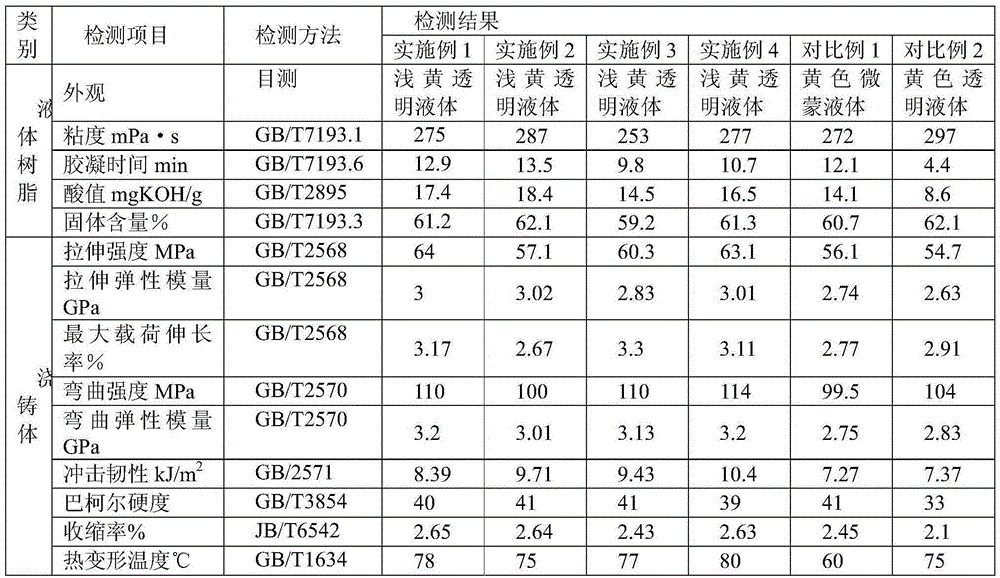Method for synthesizing unsaturated polyester resin by utilizing PET
A polyester resin, unsaturated technology, applied in the field of polymer chemistry, can solve the problems of deep appearance of resin, uncontrollable reaction, low price, etc.
- Summary
- Abstract
- Description
- Claims
- Application Information
AI Technical Summary
Problems solved by technology
Method used
Image
Examples
Embodiment 1
[0028] In a 2L four-neck flask with a thermometer, a mechanical stirrer, a nitrogen inlet tube and a reflux condenser, add 97g glycerin (technical grade, purity 95%wt.), 272g diethylene glycol, 384g waste PET and 1g For zinc acetate, turn on the mechanical stirring and stir at a speed of 260r / min. Under the protection of nitrogen, the temperature is rapidly raised to 210°C for heat preservation reaction. After all the alcoholysis of PET, continue heat preservation for 1h, and the temperature of the reactor is lowered. Lower the temperature below 150°C, add 461g of maleic anhydride, 130g of isooctyl alcohol and 76g of propylene glycol, heat up to 150°C for 0.5h, then gradually raise the temperature to 195°C for constant temperature reaction, pay attention to controlling the temperature of the distillation head, until the acid value When the water output reaches 55mgKOH / g, when the water output reaches 85-90% of the theoretical amount, the vacuum is used to force the water to be ...
Embodiment 2
[0030] In a 2L four-neck flask with a thermometer, a mechanical stirrer, a nitrogen inlet tube and a reflux condenser, add 58g glycerin (technical grade, purity 95%wt.), 380g diethylene glycol, 384g waste PET and 1g For zinc acetate, turn on the mechanical stirring and stir at a speed of 250r / min. Under the protection of nitrogen, the temperature is quickly raised to 210°C for heat preservation reaction. After all the alcoholysis of PET, continue heat preservation for 2h, and the reaction kettle cools down. Lower the temperature below 150°C, add 451g of maleic anhydride, 78g of isooctyl alcohol and 46g of propylene glycol, heat up to 155°C for 0.5h, then gradually raise the temperature to 200°C for constant temperature reaction, pay attention to controlling the temperature of the distillation head, until the acid value When the water output reaches 55mgKOH / g, when the water output reaches 85-90% of the theoretical amount, the vacuum is used to force the water to be discharged, ...
Embodiment 3
[0032]In a 2L four-neck flask with a thermometer, a mechanical stirrer, a nitrogen inlet tube and a reflux condenser, add 105g glycerin (technical grade, purity 95%wt.), 370g diethylene glycol, 346g waste PET and 0.9 g zinc acetate, turn on the mechanical stirring, stir at a speed of 280r / min, and rapidly raise the temperature to 210°C under the protection of nitrogen to carry out the heat preservation reaction. Lower the temperature below 150°C, add 459g of maleic anhydride and 140g of isooctyl alcohol, raise the temperature to 152°C and keep it warm for 0.5h, then gradually raise the temperature to 195°C for constant temperature reaction, pay attention to controlling the temperature of the distillation head until the acid value reaches 55mgKOH / g, when the water output reaches 85-90% of the theoretical amount, vacuumize to force the water out, so that the reaction is carried out until the acid value is lower than 25mgKOH / g. Cool down to 156°C and add 0.3g o-methylhydroquinon...
PUM
 Login to View More
Login to View More Abstract
Description
Claims
Application Information
 Login to View More
Login to View More - R&D
- Intellectual Property
- Life Sciences
- Materials
- Tech Scout
- Unparalleled Data Quality
- Higher Quality Content
- 60% Fewer Hallucinations
Browse by: Latest US Patents, China's latest patents, Technical Efficacy Thesaurus, Application Domain, Technology Topic, Popular Technical Reports.
© 2025 PatSnap. All rights reserved.Legal|Privacy policy|Modern Slavery Act Transparency Statement|Sitemap|About US| Contact US: help@patsnap.com

